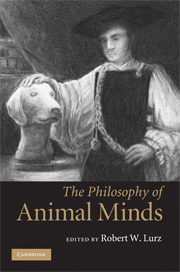Book contents
- Frontmatter
- Contents
- List of contributors
- Acknowledgments
- The philosophy of animal minds: an introduction
- 1 What do animals think?
- 2 Attributing mental representations to animals
- 3 Chrysippus' dog as a case study in non-linguistic cognition
- 4 Systematicity and intentional realism in honeybee navigation
- 5 Invertebrate concepts confront the generality constraint (and win)
- 6 A language of baboon thought?
- 7 Animal communication and neo-expressivism
- 8 Mindreading in the animal kingdom
- 9 The representational basis of brute metacognition: a proposal
- 10 Animals, consciousness, and I-thoughts
- 11 Self-awareness in animals
- 12 The sophistication of non-human emotion
- 13 Parsimony and models of animal minds
- 14 The primate mindreading controversy: a case study in simplicity and methodology in animal psychology
- Glossary of key terms
- References
- Index
5 - Invertebrate concepts confront the generality constraint (and win)
Published online by Cambridge University Press: 05 June 2012
- Frontmatter
- Contents
- List of contributors
- Acknowledgments
- The philosophy of animal minds: an introduction
- 1 What do animals think?
- 2 Attributing mental representations to animals
- 3 Chrysippus' dog as a case study in non-linguistic cognition
- 4 Systematicity and intentional realism in honeybee navigation
- 5 Invertebrate concepts confront the generality constraint (and win)
- 6 A language of baboon thought?
- 7 Animal communication and neo-expressivism
- 8 Mindreading in the animal kingdom
- 9 The representational basis of brute metacognition: a proposal
- 10 Animals, consciousness, and I-thoughts
- 11 Self-awareness in animals
- 12 The sophistication of non-human emotion
- 13 Parsimony and models of animal minds
- 14 The primate mindreading controversy: a case study in simplicity and methodology in animal psychology
- Glossary of key terms
- References
- Index
Summary
This chapter defends the claim that invertebrates possess concepts against the so-called “generality constraint,” first proposed by Evans (1982). A number of different versions of that constraint are distinguished. Some are ill-motivated. Those that aren't are not only consistent with but support the claim that invertebrates possess genuine concepts, as opposed to mere “proto-concepts,” and that invertebrates engage in genuine forms of thinking, as opposed to mere “proto-thinking.” Indeed, it turns out that distinctively human kinds of thinking contain mere faux-thoughts by comparison with those that we share with non-human animals.
INTRODUCTION
What does it take to possess a concept? Do any non-human animals have concepts? One crucial constraint on the concept concept is that concepts are the building blocks of thought. Hence no creature could count as a concept-user that wasn't capable of thinking. This mightn't seem like a significant additional restriction, but actually it has some teeth, ruling out some otherwise concept-like phenomena. Consider the Australian digger wasp (Gould and Gould [1994]). The female builds a tower-and-bell structure above the hole in which she lays her eggs, to protect them from another species of parasitic wasp. At various points during construction she uses her own body as a yardstick. For example, she stops building the tower and begins on the bell once the former is three of her own body lengths high. Does she, then, have the concept, three body lengths (or some sufficiently close analog)?
Keywords
- Type
- Chapter
- Information
- The Philosophy of Animal Minds , pp. 89 - 107Publisher: Cambridge University PressPrint publication year: 2009
- 23
- Cited by

